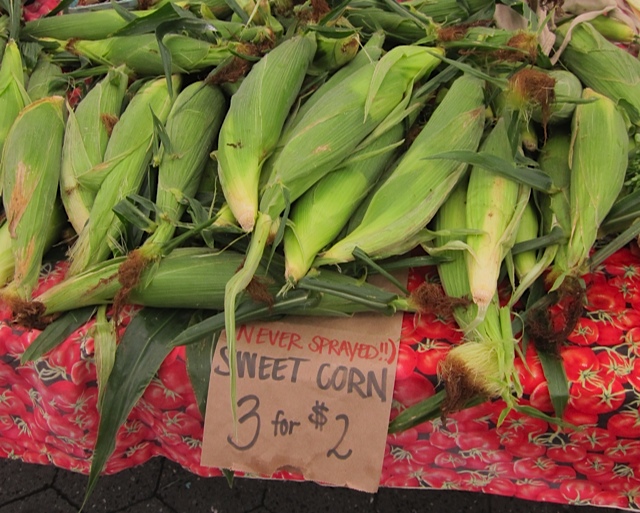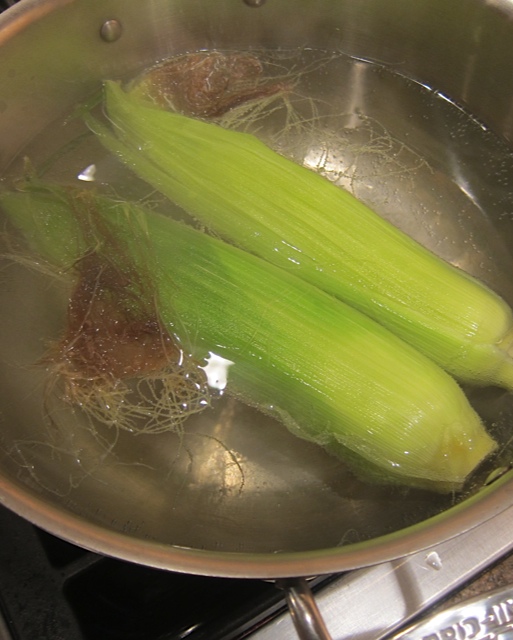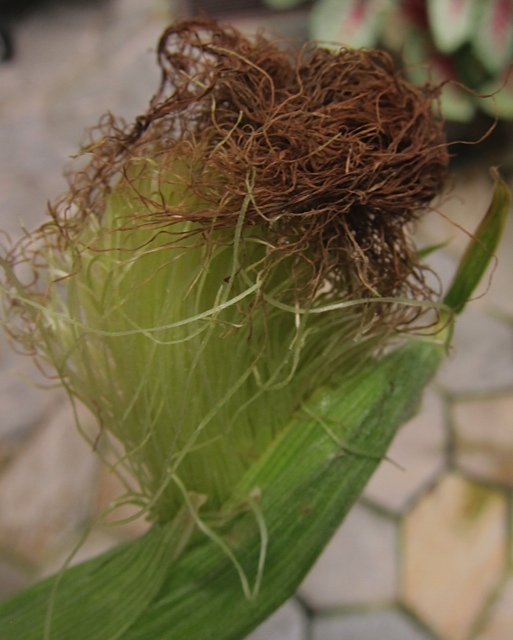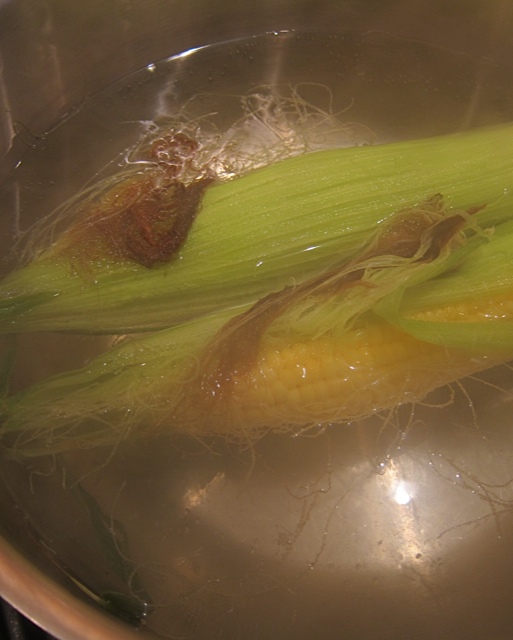
Corn at the farmers' market
And lo, and behold, the corn was harvested (starting about July 15 this year in the northeastern communities).
And it was good, brother.
And it was even better, brother, if you had applied a few simple cooking tips to one of nature's simplest dishes.
Oh, yes, there is great annual controversy about a dozen corn cooking matters that, in the end, matter not, or not a heck of a lot. For example: do I put my ears of corn in cold water and merely bring them to a boil? Or do I submerge them in boiling waters, and cook them for a specific amount of time? If so...how much time? Three minutes? Five minutes? Seven minutes?
In my kitchen, not much time is wasted worrying about these things. Oh, I'll give you a guideline before this story is out...but I think it much more important that you faithfully follow a little-known rule, the Silk-and-Tassel Rule, which maketh all the difference. This is the gestalt theory of corn: cook it in its wholeness.
It's practically a summer religion to me.
The Silk-and-Tassel Rule says "thou shalt not shuck your corn too much before cooking!" And here's the theory...
First of all, with a really fresh corn, the husk of the corn, containing those fine silk threads, along with the brown tassels at top, doesn't really want to clean up easily! You've seen this mess a hundred times, silk and tassel flying everywhere in your kitchen. But if you only partially shuck your corn, pulling off only modest amounts of leaves and silk, your pre-cook job will be easier, and your kitchen will be cleaner.
Now, if you do leave behind a considerable amount (say, 2/3) of husks, silk and tassel, and boil those with the corn...you're in for an even bigger benefit: your corn will taste more corny after it has boiled! The leaves, silk and tassels create a kind of corn "stock" in the corn water, intensifying flavor!

Ears of corn mostly unshucked in the cooking water
And then there's one more practical benefit: when you finally do remove the vegetal matter at the end of cooking...the silk, now drowned, won't fly everywhere!
So here's the whole process:
1) Select freshly-field-picked corns that are heavy for their weight. The later they were picked at the farm, and the cooler they've remained, the better. Look specifically for the condition of the tassels, because that's a good sign of insect infestation. No tassels means the farmer cut the buggy tassels away. Lots of healthy brown tassels on the corn, modulating into green-yellow silk...you're good to go!!!

An ear of corn with healthy brown tassels
2) Place a large amount of cold water in a large pot (size depends on the number of ears you're cooking...but make sure the ears will be just covered with water).
3) Partially shuck the ears, leaving behind about 2/3 leaves, silk and brown tassel.
4) Place ears in the pot, add a little salt (as for pasta cooking water), and place the pot over high heat.

Corn, leaves, silk and tassel cooking together
5) Cook until a good rolling boil develops, and the corn has a darker yellow or darker white color. I like to test one ear, just to make sure the corn is done. Average cooking time...7 or 8 minutes.
6) Now you have a little work. I transfer all of the ears to a clean sink. One by one, I put them under cold running tap water, using the flow to help me quickly pull away the now-cooked leaves, silk and tassel (which you leave behind in the sink).
7) When each corn is shucked, remove it rapidly from the cold water flow (it should still be very hot), and place it on paper towels (to absorb the extra water). From the paper towels, the corn goes right on to a buttered platter that will fit all of the corn you're cooking. For me, only butter and coarse salt are necessary!
I am sure this different cooking style will make your summer corn even more flavorful.
Let us say "amen" to that!
For more stories like these, sign-up for free weekly emails at www.dRosengarten.com.
Our 2024 Coverage Needs You
It's Another Trump-Biden Showdown — And We Need Your Help
The Future Of Democracy Is At Stake
Our 2024 Coverage Needs You
Your Loyalty Means The World To Us
As Americans head to the polls in 2024, the very future of our country is at stake. At HuffPost, we believe that a free press is critical to creating well-informed voters. That's why our journalism is free for everyone, even though other newsrooms retreat behind expensive paywalls.
Our journalists will continue to cover the twists and turns during this historic presidential election. With your help, we'll bring you hard-hitting investigations, well-researched analysis and timely takes you can't find elsewhere. Reporting in this current political climate is a responsibility we do not take lightly, and we thank you for your support.
Contribute as little as $2 to keep our news free for all.
Can't afford to donate? Support HuffPost by creating a free account and log in while you read.
The 2024 election is heating up, and women's rights, health care, voting rights, and the very future of democracy are all at stake. Donald Trump will face Joe Biden in the most consequential vote of our time. And HuffPost will be there, covering every twist and turn. America's future hangs in the balance. Would you consider contributing to support our journalism and keep it free for all during this critical season?
HuffPost believes news should be accessible to everyone, regardless of their ability to pay for it. We rely on readers like you to help fund our work. Any contribution you can make — even as little as $2 — goes directly toward supporting the impactful journalism that we will continue to produce this year. Thank you for being part of our story.
Can't afford to donate? Support HuffPost by creating a free account and log in while you read.
It's official: Donald Trump will face Joe Biden this fall in the presidential election. As we face the most consequential presidential election of our time, HuffPost is committed to bringing you up-to-date, accurate news about the 2024 race. While other outlets have retreated behind paywalls, you can trust our news will stay free.
But we can't do it without your help. Reader funding is one of the key ways we support our newsroom. Would you consider making a donation to help fund our news during this critical time? Your contributions are vital to supporting a free press.
Contribute as little as $2 to keep our journalism free and accessible to all.
Can't afford to donate? Support HuffPost by creating a free account and log in while you read.
As Americans head to the polls in 2024, the very future of our country is at stake. At HuffPost, we believe that a free press is critical to creating well-informed voters. That's why our journalism is free for everyone, even though other newsrooms retreat behind expensive paywalls.
Our journalists will continue to cover the twists and turns during this historic presidential election. With your help, we'll bring you hard-hitting investigations, well-researched analysis and timely takes you can't find elsewhere. Reporting in this current political climate is a responsibility we do not take lightly, and we thank you for your support.
Contribute as little as $2 to keep our news free for all.
Can't afford to donate? Support HuffPost by creating a free account and log in while you read.
Dear HuffPost Reader
Thank you for your past contribution to HuffPost. We are sincerely grateful for readers like you who help us ensure that we can keep our journalism free for everyone.
The stakes are high this year, and our 2024 coverage could use continued support. Would you consider becoming a regular HuffPost contributor?
Dear HuffPost Reader
Thank you for your past contribution to HuffPost. We are sincerely grateful for readers like you who help us ensure that we can keep our journalism free for everyone.
The stakes are high this year, and our 2024 coverage could use continued support. If circumstances have changed since you last contributed, we hope you'll consider contributing to HuffPost once more.
Already contributed? Log in to hide these messages.



